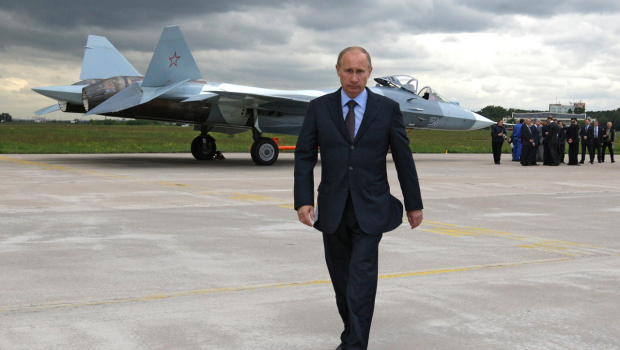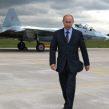
Preparing for War Against the US on All Fronts—A Net Assessment of Russia’s Defense and Foreign Policy Since the Start of 2014
Publication: Eurasia Daily Monitor Volume: 11 Issue: 183
By:

In a series of recently published interviews, President Vladimir Putin (kremlin.ru, October 15), Prime Minister Dmitry Medvedev (Interfax, October 15) and national security council secretary Nikolai Patrushev (Rossiyskaya Gazeta, October 15) have outlined Moscow’s strategic vision of the world after the Ukrainian crisis, Russia’s annexation of Crimea, the Moscow-inspired proxy war in the southeastern Donbas region of Ukraine, and resulting punitive sanctions imposed by the West. The view from Moscow is uninviting—A new cold war with the West is in the making; Russia is under attack and will use all means at its disposal to resist, including the nuclear option. Putin accused Washington of deliberately provoking the Ukraine crisis by supporting extreme nationalists in Kyiv, which in turn ignited a civil war. “Now they [the United States] accuse us of causing this crisis,” exclaimed Putin, “It is madness to blackmail Russia; let them remember, a discord between major nuclear powers may undermine strategic stability” (kremlin.ru, October 15).
Under mounting Western pressure this year, Russian leaders have been repeatedly and unambiguously reminding the West of the ultimate weapon at Moscow’s disposal—nuclear mutual assured destruction. The Russian military is also rearming and conducting massive exercises, preparing for a possible global war. The consensus view in Moscow within the political, military and intelligence community is that relations with the United States are beyond repair and, quoting Medvedev, there is no possibility of any new US-Russian “reset.” Moscow has come to believe that there is no possibility of any genuine détente with Washington until 2020 at the earliest. Indeed, National Security Council Secretary Patrushev’s interview in the official government-published Rossiyskaya Gazeta newspaper has the title: “Second Cold War.” Patrushev openly describes the US as Russia’s eternal foe and accuses Washington of planning for many decades to fully isolate Moscow and deprive it of any influence in its former dominions in the post-Soviet space. Patrushev announced (which seems to be an officially held policy opinion) that the US is today fulfilling a strategic plan to marginalize and destroy Russia—a strategy that he says was initiated in the 1970s by Zbigniew Brzezinski, the then–United States National Security Advisor to President Jimmy Carter.
The US is now seen in Moscow as irredeemable and determined to destroy Russia, which must resist by reinforcing and rearming its military, investing in technological independence (the so-called import replacement or “importozamescheniye”), and by building a world-wide anti-US alliance. To that effect, over the past year, Moscow has been strengthening its ties with Beijing. In particular, Russia has been opening itself up to Chinese investment, seeking much needed hard currency liquidity in the Chinese banking system, as well as looking for Chinese technologies (including civilian, double-use and maybe eventually military) to replace those technologies, materials, components and investments that are not forthcoming from the West because of punitive sanctions. Patrushev, in his interview, confirmed that Russian strategic planners see in the future a divided multipolar world with increasingly scarce natural resources (oil, gas, food, clear water) where Russia could dominate resource-poor Europe (see EDM, October 9). Moreover, Washington is believed to have deliberately provoked the Ukrainian crisis to reinforce the North Atlantic Treaty Organization (NATO) and blackmail its allies into full submission. As Patrushev argues, Russia, in turn, must build alliances with non-European emerging powers like China, while working to undermine the Transatlantic link to liberate Europeans from US domination.
Patrushev spells out what most of the Moscow ruling elite believes: Europeans, as well as misguided Ukrainians will soon inevitably see reason and understand that without Russia and its supplies of various natural resources, they cannot survive; whereas, Russia can do without them thanks to its warm strategic embrace with China. Moscow will not withdraw from Crimea and will not give up on its attempts to prevent Ukraine from moving closer to NATO or the European Union. Actual fighting in the Donbas region may die down as the ceasefire line of control continues to be slowly and painfully established, but the overarching new cold war with the US will endure and Ukraine shall be a major battleground—though not the only one. Therefore, the Kremlin is preparing to fight the United States on all possible fronts to push back US attempts to “contain” Russia. In line with the plans reiterated this year, additional Russian forces will be deployed in the Arctic to fend off a possible US assault. Moreover, dozens of Cold War–era military bases and airfields will be reinvigorated across the whole of the Russian Arctic; troops will be deployed together with bombers and MiG-31 interceptors. In addition, new or reinforced military garrisons will be deployed in Crimea, Belarus and Kyrgyzstan (Rossiyskaya Gazeta, October 15).
Thanks to months of sanctions and falling oil prices, the ruble is sliding against the dollar and euro. The Russian economy has continued to stagnate and may go into recession in 2015. A contraction in household income is also expected. The finance ministry is considering cuts in budget spending, but it seems defense expenditures will continue to grow. The defense budget in 2015 is planned to reach an all-time post–Cold War high of 4.2 percent of GDP or 3.3 trillion rubles ($81 billion). In 2012, defense spending was 3 percent of GDP; in 2013, it reached 3.2 percent; and in 2014, it was 3.4 percent (Interfax, October 16). Overall federal budget spending to finance Russia’s massive intelligence services and other militarized services is almost as big as the defense budget per se. And as the new cold war–type standoff widens in scope and the Russian economy flounders, the Russian people will be increasingly paying for guns instead of butter.
But the population, which has continued to be fed vicious state propaganda—especially after the Ukraine crisis began to escalate—seems to agree with the Kremlin. According to the latest poll by independent pollster Levada Center, a majority believe Western sanctions are designed to punish the overall population, but the majority have not yet felt any sanction effect. Furthermore, some 60 percent agree that the property and assets of Western companies in Russia may be confiscated as a practical reply to sanctions, and 58 percent agree with a possible boycott of foreign produce. Fifty-nine percent believe that Western punitive sanctions and Russian countermeasures like the ban on Western food will, in fact, enhance Russia’s economic development. And the vast majority of Russians—79 percent—are against giving up Crimea (Interfax, October 16).
During all of 2014, Russia’s rulers and most of the population seem to have been living together in a daydream. Consequently, Russian defense and foreign policy plans as well as the country’s decision making apparatus have, for months, been based on little more than strange fantasies and outlandish assumptions. Yet, these fantasies are backed up by a formidable military machine, billions of petrodollars and a nuclear superpower arsenal of weapons of mass destruction. And this is a truly dangerous mix.




